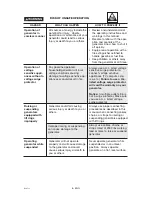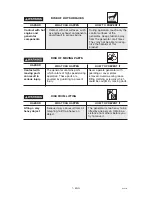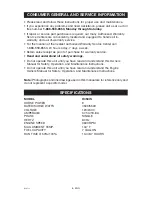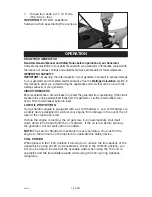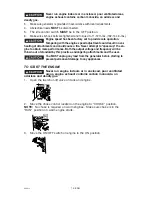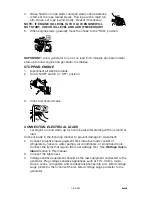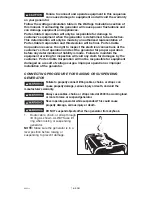
3- ENG
D28512
Attempting to connect to the in-
coming utility service could result
in electrocution.
Restoration of electrical service
while the generator is connected
to the incoming utility could
result in a fire or serious damage
if an isolator switch is not
installed.
Failure to use a double throw
transfer switch when connecting
to a structure's electrical system
can damage appliances and
WILL VOID
the manufacturer's
warranty.
To connect to a structure's electri-
cal system in a safe manner,
always have a Double-Throw
Transfer Switch installed by a
qualified electrician and in compli-
ance with local ordinances.
(When installing a Double-
Throw Transfer Switch, a mini-
mum of 10 gauge wiring must
be used.)
RISK OF ELECTROCUTION AND FIRE
(Continued)
HAZARD
WHAT CAN HAPPEN
HOW TO PREVENT IT
Operation of
generator in rain,
wet, icy, or
flooded
conditions.
Water is an excellent conductor
of electricity! Water which comes
in contact with electrically
charged components can
transmit electricity to the frame
and other surfaces, resulting in
electrical shock to anyone con-
tacting them.
Operate generator in a clean, dry,
well ventilated area. Make sure
hands are dry before touching
unit.
Use of worn,
damaged, under-
sized or un-
grounded exten-
sion cords.
Use of ungrounded cordsets
could prevent operation of
circuit breakers and result in
electrical shock.
Always use a cordset having a
grounding wire with an
appropriate grounding plug. DO
NOT use an ungrounded plug.
Use proper size (wire gauge)
cordset for application see chart
in the Assembly section of this
manual.
Contact with worn or damaged
extension cords could result in
electrocution.
Use of undersize extension
cords could result in overheating
of the wires or attached items,
resulting in fire.
Inspect extension cords before
use and replace with new cord if
required.
Placing generator
on or against
highly conductive
surface, such as a
steel walkway or
metal roof.
Place generator on low conduc-
tivity surface such as a concrete
slab.
Accidental leakage of electrical
current could charge conductive
surfaces in contact with the
generator.
ALWAYS operate generator a
minimum of six feet from any
conductive surface.
Improper
connection of
items to
generator.
Exceeding the load capacity of
the generator by attaching too
many items, or items with very
high load ratings to it could
result in overheating of some
items or their attachment wiring
resulting in fire or electrical
shock.
Read the load rating chart and
instructions in the Wattage Cal-
culation section. Make sure that
the summation of electrical
loads for all attachments does
not exceed the load rating of the
generator.
Attempting to
connect generator
directly to the
electrical system
of any building
structure.
(Continued)






